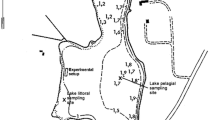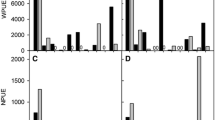Abstract
The feasibility of biomanipulation is related particularly to reducing the production and recruitment of planktivorous fish stocks. For assessing the level of predation needed to suppress planktivorous fish stocks, the relation between fish P and B, on one hand, and nutrient concentration on the other were analyzed. The carrying capacity of shallow lakes in terms of biomass is related to the total phosphorus concentration and nature of the lake bottom substrate. The production of planktivorous fish was 60–80% of the maximum carrying capacity. It is argued that aquatic vegetation and northern pike are effective tools to maintain water quality, but these are limited by the maximum nutrient concentration aquatic vegetation can sustain.
Access this chapter
Tax calculation will be finalised at checkout
Purchases are for personal use only
Preview
Unable to display preview. Download preview PDF.
Similar content being viewed by others
References
Backx, J. J. G. M. 1989. Waarnemingen aan de visstand in the Veluwemeer en Wolderwijd in de periode 1966–1987. Rapport Vakgroep Visteelt and Visserij, Landbouwuniversiteit Wageningen, 36 pp.
Barthelmes, D., 1988. Fish predation and resource reaction: biomanipulation background data from fisheries research. Limnologia 19: 51–59.
Benndorf, J., H. Schultz, A. Benndorf, R. Unger, E. Penz, H. Kneschke, K. Kossatz, R. Dumke, U. Hornig, R. Kruspe and S. Reichel, 1988. Food-web manipulation by enhancement of piscivorous fish stocks: long-term effects in the hypertrophie Bautzen Reservoir. Limnologica 19: 97–110.
Bregazzi, P. R. and C. R. Kennedy, 1982. The responses of a perch, Perca fluviatilis L., population to eutrophication and associated changes in fish fauna in a small lake. J. Fish Biol. 20: 21–31.
Chapman, C. A. and W. C. Mackay, 1984. Direct observation of habitat utilization by northern pike. Copeia 1984 (1): 225–258.
Goldspink, C. R., 1978. The population density, growth rate and production of bream, Abramis brama, in Tjeukemeer, the Netherlands. J. Fish Biol. 13: 499–517.
Goldspink, C. R., 1979. The population density, growth rate and production of roach, Rutilus rutilus (L.) in Tjeukemeer, The Netherlands. J. Fish Biol. 15: 473–498.
Grimm, M. P., 1981. The composition of northern pike (Esox lucius L.) populations in four shallow waters in The Netherlands, with special reference to factors influencing 0+ pike biomass. Fish Manag. 12: 61–77.
Grimm, M. P., 1983. Regulation of biomasses of small ()cm) northern pike (Esox lucius L.) with special reference to the contribution of individuals stocked as fingerlings (4–6 cm). Fish Manag. 14: 115–135.
Grimm, M. P. and E. Van Donk, 1989. Mogelijkheden voor de toepassing van actief biologisch beheer in de Vechtplassen. In Integraal waterbeheer in the Goois/Utrechts Stuwwallen-en Plassengebied. CHO-TNO: 167–179.
Grimm, M. P., 1989. Northern pike (Esox lucius L.) and aquatic vegetation, tools in the management of fisheries and water quality in shallow waters. Hydrobiol. Bull. 23: 61–67.
Hanson, J. M. and W. C. Leggett, 1982. Emperical prediction of fish biomass and yield. Can. J. Fish. aquat. Sci. 39: 257–263.
Hartmann, J., 1977. Fischereiliche Veränderungen in kulturbedingt eutrophierenden Seen. Schweiz. Z. Hydrol. 39: 243–254.
Hofer, R. and R. Niederholzer, 1978. Einflusen der rotaugen population auf den Charabestand (Armleuchteralgen) des Möserer See ( Tirol ). Ostenreichs fisherei 31: 12–17.
Hosper, S. H., 1989. Biomanipulation, new perspectives for restoration of shallow, eutrophic lakes in the Netherlands. Hydrobiol. Bull. 23: 5–10.
Kampen, J., 1989. De visstand in de Kleine Widen vanaf 1979 tot 1987. Nieuwegein, Organisatie ter Verbetering van de Binnenvisserij. Onderzoeksrapport 1989–13, 30 pp.
Keto, J. and I. Sammalkorpi, 1988. A fading recovery: A conceptual model for Lake Vesijärvi management and research. Aqua Fennica 18, 2: 193–204.
Klein Breteler, J. G. P., 1989. De ontwikkeling van de vis-stand in Zwemlust in 1988. O.V.B. rapport PWU/OVB 88–01, 10 pp.
Lammens, E. H. R. R., 1986. Interactions between fishes and the structure of fish communities in Dutch shallow, eutrophic lakes. PhD thesis. Agricultural University Wageningen, 100 pp.
Lammens, E. H. R. R., 1989. Cause and consequences of the success of bream in dutch eutrophic lakes. Hydrobiol. Bull. 23: 11–18.
Langeland, A., 1982. Interactions between zooplankton and fish in a fertilized lake. Holarct. Ecol. 5: 273–310.
Leentvaar, P., 1980. Eutrofication, nature management and the role of potassium. Hydrobiol. Bull. 14: 22–30.
Matsuoka, Y., T. Goda and M. Naito, 1986. An eutrophication model of lake Kasumigaura. Ecological Modelling 31: 201–219.
Meijer, M.-L., A. J. P. Raat and R. Doef, 1989. Biomanipulation as restoration method for the Bleiswijkse Zoom, first results. Hydrobiol. Bull. 23: 51–59.
Meijer, M.-L., M. W. de Haan, A. W. Breukelaar and H. Buiteveld, 1990. Is reduction of the benthivorous fish an important cause of high transparency following biomanipulation in shallow lakes? Hydrobiologia 200 /201: 303–315.
Prejs, A. and H. Jackowska, 1978. Lake macrophytes as the food of roach (Rutilus rutilus L.) and rudd (Scardinius erythrophthalmus L.). I. Species composition and dominance relations in the lake and food. Ekol. Pol. 26: 429–438.
Raat, A. J. P., 1988. Synopsis of biological data on the northern pike Esox lucius Linnaeus, 1958. FAO Fisheries Synopsis No. 30 Rev. 2, 178 pp.
Raat, A. J. P., 1989. Growth and production of 0 + bream (Abramis brama), 0+ roach (Rutilus rutilus) and 0+ carp (Cyprinus carpio) in 10 drainable 0.1 ha ponds. Hydrobiol. Bull. 23: 67–72.
Raat, A. J. P., 1990. Production, consumption and prey availability of northern pike (Esox lucius), pikeperch (Stizostedion lucjoperca) and European catfish (Silurus glanis): a bioenergetic approach. Hydrobiologia 200 /201: 497–509.
Raat, A. J. P. and G. Laak de, 1989. De visstand in het Noorddiep 3 in 1988. Nieuwegein, Organisatie ter Verbetering van de Binnenvisserij. Onderzoeksrapport versie 12 mei 1989, 10 pp.
Ricker, W. E., 1975. Computation and interpretation of biological statistics of fish populations. Bull. Fish. Res. Bd Can. 191, 382 pp.
Schäperclaus, W., 1961. Lehrbuch der Teichwirtschaft. Paul Parey. Berlin. 582 pp.
Scheffer, M., 1990. Multiplicity of stable states in freshwater systems. Hydrobiologia 200 /201: 475–486.
Shapiro, J. and D. I. Wright, 1984. Lake restoration by biomanipulation: Round Lake, Minnesota, the first two years. Freshwat. Biol. 14: 371–383.
Shapiro, J., V. Lamarra and M. Lynch, 1975. Biomanipulation: the ecosystem approach to lake restoration. In Water quality management through biological control. Symposium Univ. Florida, Gainesville: 85–96.
Tomcko, C. M., R. A. Steins and R. F. Carline, 1984. Predation by tiger muskellunge on blue-gill: effects of predator experience, vegetation, and prey density. Trans. Am. Fish. Soc. 113: 588–594.
Donk, E., R. M. Gulati and M. P. Grimm, 1989. Food-web manipulation in Lake Zwemlust: Positive and negative effects during the first two years. Hydrobiol. Bull. 23: 19–34.
Vree, H. A. G. M. de, 1984. De `Kleine Widen’. De evaluatie van Pootsnoek 1977–1978. Rapporten Buitenwater, OVB rapport, 102 pp.
Willemsen, J., 1980. Fishery-aspects of eutrophication. Hydrobiol. Bull. 14: 12–21.
Author information
Authors and Affiliations
Editor information
Editors and Affiliations
Rights and permissions
Copyright information
© 1990 Springer Science+Business Media Dordrecht
About this paper
Cite this paper
Grimm, M.P., Backx, J.J.G.M. (1990). The restoration of shallow eutrophic lakes, and the role of northern pike, aquatic vegetation and nutrient concentration. In: Gulati, R.D., Lammens, E.H.R.R., Meijer, ML., van Donk, E. (eds) Biomanipulation Tool for Water Management. Developments in Hydrobiology, vol 61. Springer, Dordrecht. https://doi.org/10.1007/978-94-017-0924-8_50
Download citation
DOI: https://doi.org/10.1007/978-94-017-0924-8_50
Publisher Name: Springer, Dordrecht
Print ISBN: 978-90-481-4074-9
Online ISBN: 978-94-017-0924-8
eBook Packages: Springer Book Archive




